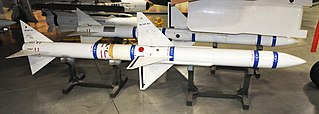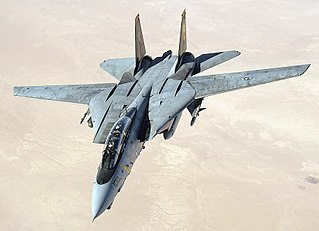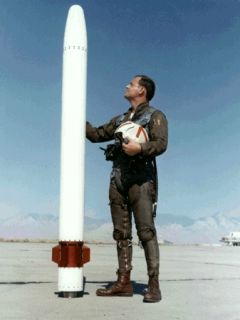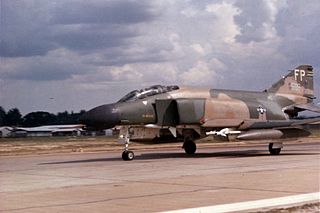
The AIM-7 Sparrow is an American, medium-range semi-active radar homing air-to-air missile operated by the United States Air Force, United States Navy, and United States Marine Corps, as well as other various air forces and navies. Sparrow and its derivatives were the West's principal beyond visual range (BVR) air-to-air missile from the late 1950s until the 1990s. It remains in service, although it is being phased out in aviation applications in favor of the more advanced AIM-120 AMRAAM.
The AIM-120 Advanced Medium-Range Air-to-Air Missile, or AMRAAM, is an American beyond-visual-range air-to-air missile (BVRAAM) capable of all-weather day-and-night operations. It is 7 inches (18 cm) in diameter, and employs active transmit-receive radar guidance instead of semi-active receive-only radar guidance. It is a fire-and-forget weapon, unlike the previous generation Sparrow missiles which needed guidance from the firing aircraft. When an AMRAAM missile is launched, NATO pilots use the brevity code Fox Three.
The AIM-54 Phoenix is an American radar-guided, long-range air-to-air missile (AAM), carried in clusters of up to six missiles on the Grumman F-14 Tomcat, its only operational launch platform.

The Grumman F-14 Tomcat is an American carrier-capable supersonic, twin-engine, two-seat, twin-tail, variable-sweep wing fighter aircraft. The Tomcat was developed for the United States Navy's Naval Fighter Experimental (VFX) program after the collapse of the General Dynamics-Grumman F-111B project. The F-14 was the first of the American Teen Series fighters, which were designed incorporating air combat experience against MiG fighters during the Vietnam War.

The Panavia Tornado Air Defence Variant (ADV) was a long-range, twin-engine interceptor version of the swing-wing Panavia Tornado. The aircraft's first flight was on 27 October 1979, and it entered service with the Royal Air Force (RAF) in 1986. It was also operated by the Italian Air Force (AMI) and the Royal Saudi Air Force (RSAF).

The Advanced Short Range Air-to-Air Missile (ASRAAM), also known by its United States designation AIM-132, is an imaging infrared homing air-to-air missile, produced by MBDA UK, that is designed for close-range combat. It is in service in the Royal Air Force (RAF) and Royal Australian Air Force (RAAF), replacing the AIM-9 Sidewinder. ASRAAM is designed to allow the pilot to fire and then turn away before the opposing aircraft can close for a shot. It flies at well over Mach 3 to ranges in excess of 25 kilometres (16 mi). It retains a 50 g manoeuvrability provided by body lift technology coupled with tail control.

The IRIS-T is a German-led program to develop a short to medium range infrared homing air-to-air missile to replace the AIM-9 Sidewinder found in some NATO member countries. Any aircraft capable of firing the Sidewinder is also capable of launching the IRIS-T.

An air-to-air missile (AAM) is a missile fired from an aircraft for the purpose of destroying another aircraft. AAMs are typically powered by one or more rocket motors, usually solid fueled but sometimes liquid fueled. Ramjet engines, as used on the Meteor, are emerging as propulsion that will enable future medium-range missiles to maintain higher average speed across their engagement envelope.

The Skyflash, or Sky Flash in marketing material, was a medium-range semi-active radar homing air-to-air missile derived from the US AIM-7 Sparrow missile and carried by Royal Air Force McDonnell Douglas F-4 Phantoms and Tornado F3s, Italian Aeronautica Militare and Royal Saudi Air Force Tornados and Swedish Flygvapnet Saab Viggens.

The R-73 is a short-range air-to-air missile developed by Vympel NPO that entered service in 1984.

Strike Fighter Squadron 213 (VFA-213) Blacklions is an aviation unit of the United States Navy based at Naval Air Station Oceana, Virginia. It was established in 1955 and is currently equipped with the F/A-18F Super Hornet. The squadron is assigned to Carrier Air Wing Eight and uses the radio callsign Lion.
A beyond-visual-range missile (BVR) is an air-to-air missile (BVRAAM) that is capable of engaging at ranges of 20 nmi (37 km) or beyond. This range has been achieved using dual pulse rocket motors or booster rocket motor and ramjet sustainer motor.

The R.550 Magic is a short-range air-to-air missile designed in 1968 by French company Matra to compete with the American AIM-9 Sidewinder, and it was made backwards compatible with the Sidewinder launch hardware.

The AIM-95 Agile was an air-to-air missile developed by the United States. It was developed by the US Navy to equip the F-14 Tomcat, replacing the AIM-9 Sidewinder. Around the same time, the US Air Force was designing the AIM-82 to equip their F-15 Eagle, and later dropped their efforts to join the Agile program. In the end, newer versions of Sidewinder would close the performance gap so much that the Agile program was cancelled.
VFAX for Naval Fighter Attack Experimental was actually two specifications for two US Naval fighter projects. The first was for a low cost lightweight complement for the F-111B which could replace the F-4 Phantom II for air superiority, escort, and ground attack missions in the early 1960s. This role was dropped in favor of the VFX aircraft, which emerged as the F-14 Tomcat. The second VFAX evolved when the VFX proved too costly to replace all existing fighters and attack aircraft, and the Navy was invited to take part in the USAFs Lightweight Fighter Program (LWF). The Navy chose the "loser" of the LWF contest for its VFAX role as it was inherently more suitable to naval operations than the winner; it was redesigned to become the F/A-18 Hornet.
The Grumman F-14 Tomcat has served with the United States Navy and the Islamic Republic of Iran Air Force (IRIAF) It operated aboard U.S. aircraft carriers from 1974 to 2006 and remains in service with Iran. In-depth knowledge of its service with Iran is relatively limited.
VX-4, Air Test and Evaluation Squadron Four,, commonly referred to by its nickname, The Evaluators) was a United States Navy air test and evaluation squadron based at Naval Air Station Point Mugu, California. Their tail code was XF, and they flew the McDonnell Douglas F-4 Phantom, Grumman F-14 Tomcat and the McDonnell Douglas F/A-18 Hornet until their disestablishment in 1994.

Operation Bolo was a United States Air Force mission during the Vietnam War, considered to be a successful combat ruse.

The AIM-9 Sidewinder is a short-range air-to-air missile which entered service with the US Navy in 1956 and subsequently was adopted by the US Air Force in 1964. Since then the Sidewinder has proved to be an enduring international success, and its latest variants remain standard equipment in most Western-aligned air forces. The Soviet K-13, a reverse-engineered copy of the AIM-9B, was also widely adopted by a number of nations.

The Short Range Air-to-Air Missile, or SRAAM for short, initially known as Taildog, was an experimental British infrared homing air-to-air missile, developed between 1968 and 1980 by Hawker Siddeley Dynamics. It was designed to be very manoevrable for use at short range in a dogfight situation. SRAAM was unusual in that it was launched from a launch tube instead of being attached to a launch rail, allowing two to be carried on single mounting point.













